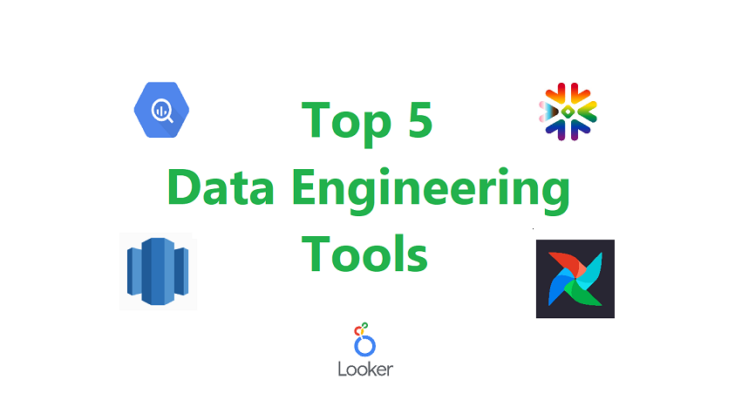There’s no denying the fact that data engineering has become one of the most sought after jobs in the Data domain and holds a lot of importance in the success of an organization. The primary focus of the data engineer is to monitor, build and simplify complex data models in order to help achieve the best business outcomes with the appropriate use of Data.
These are a few Data Engineering tools that are a must know for any 2022 Data Engineer looking for the best results. Have a look:
 Big Query: This is a cloud Data Warehouse commonly used by Data Engineering companies that are well versed in the use of Google Cloud Platform. This tool can be used by engineers and analysts right when the company is in its initial stage and scale along with the growth in the amount of data. It is also known for its adept machine learning capacities.
Big Query: This is a cloud Data Warehouse commonly used by Data Engineering companies that are well versed in the use of Google Cloud Platform. This tool can be used by engineers and analysts right when the company is in its initial stage and scale along with the growth in the amount of data. It is also known for its adept machine learning capacities. Amazon Redshift: This is another fully manage cloud warehouse tool, created by Amazon, as the name suggests. During research it was found that it is very widely used in different set ups. Powering several businesses, this tool is easy to use, set up and grow, together with growing data.
Amazon Redshift: This is another fully manage cloud warehouse tool, created by Amazon, as the name suggests. During research it was found that it is very widely used in different set ups. Powering several businesses, this tool is easy to use, set up and grow, together with growing data.-
 Looker: Another top name in the league is Looker, which is a BI software that essentially is used for data visualization. It is a popular tool and is used by different engineering teams across industries. Different from many BI tools, Looker is known to have created its own LookML Layer. Simple speaking, it is a language that is used to describe different calculations, aggregates, data relationships and dimensions related to an SQL database. Spectacles is a new tool that has recently been launched as a way to manage LookML Layer teams.
Looker: Another top name in the league is Looker, which is a BI software that essentially is used for data visualization. It is a popular tool and is used by different engineering teams across industries. Different from many BI tools, Looker is known to have created its own LookML Layer. Simple speaking, it is a language that is used to describe different calculations, aggregates, data relationships and dimensions related to an SQL database. Spectacles is a new tool that has recently been launched as a way to manage LookML Layer teams.  Airflow: This workflow management platform created by Apache is open source in nature. It was created back in the October of 2014 at Airbnb, in order to manage the complex workflows that had been becoming a hassle. With the help of Airflow, Airbnb was able to schedule and handle their workflows, together with appropriate monitoring, with the help of the Airflow user interface. This is also one of the most commonly used workflow management system across different industries.
Airflow: This workflow management platform created by Apache is open source in nature. It was created back in the October of 2014 at Airbnb, in order to manage the complex workflows that had been becoming a hassle. With the help of Airflow, Airbnb was able to schedule and handle their workflows, together with appropriate monitoring, with the help of the Airflow user interface. This is also one of the most commonly used workflow management system across different industries. Snowflake: The last on the list is Snowflake, which is known to deliver elasticity, scale, concurrency in the data architecture process. The reason for Snowflake to be this popular is its data computing and storage capabilities, which means more and more teas are expected to shift to it in the future. What’s great about it is that in Snowflake, there is independent data workload scalability, which makes it most suitable for data engineering, data lakes, data warehousing, data science as well as different data application development projects.
Snowflake: The last on the list is Snowflake, which is known to deliver elasticity, scale, concurrency in the data architecture process. The reason for Snowflake to be this popular is its data computing and storage capabilities, which means more and more teas are expected to shift to it in the future. What’s great about it is that in Snowflake, there is independent data workload scalability, which makes it most suitable for data engineering, data lakes, data warehousing, data science as well as different data application development projects.


 Big Query: This is a cloud Data Warehouse commonly used by
Big Query: This is a cloud Data Warehouse commonly used by  Amazon Redshift: This is another fully manage cloud warehouse tool, created by Amazon, as the name suggests. During research it was found that it is very widely used in different set ups. Powering several businesses, this tool is easy to use, set up and grow, together with growing data.
Amazon Redshift: This is another fully manage cloud warehouse tool, created by Amazon, as the name suggests. During research it was found that it is very widely used in different set ups. Powering several businesses, this tool is easy to use, set up and grow, together with growing data. Looker: Another top name in the league is Looker, which is a BI software that essentially is used for data visualization. It is a popular tool and is used by different engineering teams across industries. Different from many BI tools, Looker is known to have created its own LookML Layer. Simple speaking, it is a language that is used to describe different calculations, aggregates, data relationships and dimensions related to an SQL database. Spectacles is a new tool that has recently been launched as a way to manage LookML Layer teams.
Looker: Another top name in the league is Looker, which is a BI software that essentially is used for data visualization. It is a popular tool and is used by different engineering teams across industries. Different from many BI tools, Looker is known to have created its own LookML Layer. Simple speaking, it is a language that is used to describe different calculations, aggregates, data relationships and dimensions related to an SQL database. Spectacles is a new tool that has recently been launched as a way to manage LookML Layer teams. Airflow: This workflow management platform created by Apache is open source in nature. It was created back in the October of 2014 at Airbnb, in order to manage the complex workflows that had been becoming a hassle. With the help of Airflow, Airbnb was able to schedule and handle their workflows, together with appropriate monitoring, with the help of the Airflow user interface. This is also one of the most commonly used workflow management system across different industries.
Airflow: This workflow management platform created by Apache is open source in nature. It was created back in the October of 2014 at Airbnb, in order to manage the complex workflows that had been becoming a hassle. With the help of Airflow, Airbnb was able to schedule and handle their workflows, together with appropriate monitoring, with the help of the Airflow user interface. This is also one of the most commonly used workflow management system across different industries. Snowflake: The last on the list is Snowflake, which is known to deliver elasticity, scale, concurrency in the data architecture process. The reason for Snowflake to be this popular is its data computing and storage capabilities, which means more and more teas are expected to shift to it in the future. What’s great about it is that in Snowflake, there is independent data workload scalability, which makes it most suitable for data engineering, data lakes, data warehousing, data science as well as different data application development projects.
Snowflake: The last on the list is Snowflake, which is known to deliver elasticity, scale, concurrency in the data architecture process. The reason for Snowflake to be this popular is its data computing and storage capabilities, which means more and more teas are expected to shift to it in the future. What’s great about it is that in Snowflake, there is independent data workload scalability, which makes it most suitable for data engineering, data lakes, data warehousing, data science as well as different data application development projects.

